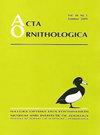摩洛哥西南部放牧草原与灌溉农田欧亚石鸻的繁殖生物学差异?
IF 1.3
4区 生物学
Q3 ORNITHOLOGY
引用次数: 0
摘要
摘要由于农业集约化和土地遗弃,与草原和伪草原栖息地有关的鸟类是欧洲最受威胁的鸟类群落之一。北非正在大规模地将自然和农村地区转变为灌溉农田,但这种栖息地改变对草原鸟类物种的影响尚未调查。本研究对摩洛哥西南部放牧草原和灌溉农田中欧亚石鸻的繁殖生物学进行了研究。在2017年和2018年的繁殖季节,收集了59个巢穴的繁殖数据。放牧草原的鸡蛋体积显著高于灌溉农田(37.3±2.30 cm3 vs 35.1±2.11 cm3,平均±SD),这可能是由于放牧草原的食物供应更充足。另一方面,与其他地区的数据相比,不同栖息地之间孵化期间的每日巢存活率没有差异,而且相当高(0.85 [95% CI: 0.71-0.93])。这些结果表明,在以传统畜牧业为特征的保护区筑巢的鸟类可能会找到更好的繁殖条件,使它们能够产下更大的蛋。此外,该地区正在进行的农业集约化进程似乎并不影响巢衰竭的可能性。我们的数据增加了少数可用的证据,关于繁殖栖息地对石鸻在其分布的南部范围内的生殖生物学的影响。需要进一步的数据来理解我们的研究结果的保护意义,特别是观察到的鸡蛋大小的变化如何影响小鸡的质量和存活率。本文章由计算机程序翻译,如有差异,请以英文原文为准。
Does the Breeding Biology of the Eurasian Stone-Curlew Burhinus oedicnemus in South-Western Morocco Differ between Grazed Steppe and Irrigated Farmland?
Abstract. Birds associated with steppe and pseudosteppe habitats are one of the most threatened avian communities in Europe, given their recent decline due to agriculture intensification and land abandonment. Large-scale conversion of natural and rural areas into irrigated farmlands is ongoing in North Africa, but the effects of this habitat modification on steppe bird species are not investigated. In this study, we investigated the breeding biology of the Eurasian Stone-curlew nesting in grazed steppes and irrigated farmlands in south-western Morocco. Breeding data were collected during 2017 and 2018 breeding seasons on 59 nests. Egg volume was significantly higher in grazed steppes than in irrigated farmlands (37.3 ± 2.30 cm3 vs 35.1 ± 2.11 cm3, average ± SD), possibly due to greater food availability in the former habitat. On the other hand, daily nest survival over the incubation period did not differ between habitats and it was quite high (0.85 [95% CI: 0.71–0.93]) also when compared to the data available for other regions. These results suggest that birds nesting in protected areas characterized by traditional pastoralism might find better conditions for reproduction which allow them to lay larger eggs. In addition, the ongoing process of agricultural intensification in the area does not seem to affect the likelihood of nest failure. Our data add to the few available pieces of evidence regarding the effect of breeding habitat on the reproductive biology of the Stone-curlew in the southern range of its distribution. Further data are needed in order to understand the conservation implication of our findings and, in particular, how the observed variability of egg size might affect chick quality and survival.
求助全文
通过发布文献求助,成功后即可免费获取论文全文。
去求助
来源期刊

Acta Ornithologica
生物-鸟类学
CiteScore
2.10
自引率
0.00%
发文量
14
审稿时长
>12 weeks
期刊介绍:
Publishes scientific papers (original research reports, reviews, short notes, etc.) and announcements from all fields of ornithology. All manuscripts are peer-reviewed.
Established in 1933 as Acta Ornithologica Musei Zoologici Polonici, since 1953 continued under the present title.
Published twice a year by the Natura Optima Dux Foundation under the auspices of the Museum and Institute of Zoology, Polish Academy of Sciences.
 求助内容:
求助内容: 应助结果提醒方式:
应助结果提醒方式:


